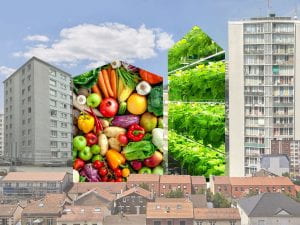The collages are our proposal for the visual identity. We imagine them being used as a printed posters, digital content, website material, and as a part of leaflets. The shape of the buildings is filled with images related to what the cité maraichère offers and contrasts with the Romainville rough urban landscape.
Without no doubt Romainville has an extremely interesting historically wise backstory however one aspect that we found particularly striking comes more from the future than from the past – the Cité Maraîchère, built in the Marcel-Cachin district in the place of old market.
When thinking about urban areas we typically imagine concrete jungles filled out with towering skyscrapers, constant traffic and people who are always in a rush. The city is hardly ever seen as a nature friendly place as it has dominated and surpassed what was once unadulterated with anything artificial. So how do the natural process occur within an urban scenery?
Food growing and harvesting is a natural cycle that on a big scale almost never happens in urban areas. The Cité Maraîchère is an innovative solution that allows for a soil-less production of around 12 tonnes of fruit and vegetables and 4 tonnes of mushrooms yearly. It is the fist of its kind in Europe. What is unique is also the fact that it will use natural and no artificial light. The philosophy of this place is to cultivate ecology therefore solutions like gathering waste from the city have been implemented as a substitute to using any form of chemical fertilisers. This circular economy, and system of watering drop by drop mean that this solution is forward thinking, focused on sustainability.
On site there are around 30 companies with more than 500 job opportunities that are constantly working on developing new techniques allowing for ecological production in urban areas.
Another interesting point worth mentioning is the fact that bio foods that are ecologically certified are often much more expensive than uncertified products that have been grown being chemically enhanced therefore projects like these are a big hope towards healthy food being accessible to everyone no matter their financial status, although the legislation does not allow the produce to have official certificate. It will also be a place for community to meet in the cafe/restaurant, offering also the educational workshop and creating jobs.
Sources of photos:
https://inseinesaintdenis.fr/a-romainville-cest-jardinage-au-dernier-etage
https://www.pinterest.fr/pin/825918019148358717/
https://www.lesechos.fr/2017/08/immobilier-romainville-se-prepare-a-larrivee-du-grand-paris-180684
https://www.bonjour-pantin.fr/2019/11/10/a-quoi-sert-la-tour-tdf-de-romainville/
https://people.com/health/eating-five-servings-fruits-vegetables-daily-lead-longer-life/
Sources of information:
https://www.parisecologie.com/Archives/Evenements2018/AgricultureUrbaineRomainville.htm
http://ilimelgo.com/en/projects/vertical-farm.html
Problems with vertical farm designs
